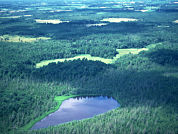Epistemological and ontological assumptions present in the history of ecology
DOI:
https://doi.org/10.25260/EA.16.26.3.0.260Abstract
The purpose of this paper is to show the epistemological assumptions (empiricists, rationalists and ratioempirist) and ontological (individualistic, holistic and systemist) present in the history of ecology, analyzing three jobs (Clements 1916; Gleason 1926; Lindeman 1942). This article analyzes the emergence in the history of the ecology of a moderate position. We defend the thesis that from the work developed by Lindeman in 1942 began to emerge in ecology a conceptual framework that implicitly takes a systemist ontological and racioempirista epistemological approach, and fits into the philosophical principles developed by Bunge. We also show the disadvantages of implementing the rationalist and empiricist epistemology in ecological research, and the advantages of using the ratioempiricism epistemology. Currently, research programs in ecology follow one of three ontological and epistemological principles.
References
Alpine, A., and J. Cloern. 1992. Trophic interactions and direct physical effects control phytoplankton biomass and production in an estuary. The American Society of Limnology and Oceanography 37(5):946-955.
Anderson, C., and A. Rosemon. 2007. Ecosystem engineering by invasive exotic beavers reduces in-stream diversity and enhances ecosystem function in Cape Horn, Chile. Oecologia 154:141–153
Ayala, F. 1968. Biology as an autonomous science. Am. Sci. 56:207-221.
Begon, M., J. L. Harper, and C. R. Towssend. 2008. Ecology: individuals, populations and communities. third edition. Blackwell Science Ltd.
Bunge, M. 1959. Causality. The place of the causal principle in moderns science. Harvard University Press. Cambridge, MA.
Bunge, M. 1979. Ontology II. A world of systems. Dordrecht, Reidel.
Bunge, M. 1985. Teoría y realidad. Ed. Ariel. Barcelona.
Bunge, M. 1995. Sistemas sociales y filosofía. Sudamericana. Buenos Aires, Argentina.
Bunge, M. 1997. Mechanism and explication. Philosophy and social sciences 27:410-465.
Bunge, M. 1999. Las ciencias sociales en discusión. Sudamérica. Buenos Aires, Argentina.
Bunge, M. 2000. La investigación científica. Siglo veintiuno, México.
Cambell, D. 1974. Downward causation in hierarchically organized biological system. Pp 179-1286 In: F. Ayala and Dobzhansky (eds.). Studies in the philosophy of biology. Mac Millan, London.
Caroso, N., J. Cole, and D. Strayer. 2006. Top-down control from the bottom: Regulation of eutrophication in a large river by benthic grazing. The American Society of Limnology and Oceanography 51: 664-670.
Carpenter, S. R., S. W. Chisholm, D. W. Schindler, and R. F. Wright. 1995. Ecosystem experiments, Science 269:324-327.
Clements, F. 1916. Plant Succession: An Analysis of the Development of Vegetation. Published by the Carnegie Institution of Washington, Washington, USA.
Cowles, H. 1899. The Ecology Relations of Vegetation on the Sand Dunes of Lake Michigan. Part I Geographical Relations of the Dunes Floras. Botanical Gazette. 27:95-117.
Cueto, V. R. 2006. Escalas en ecología: su importancia para el estudio de la selección de hábitat en aves. Hornero 21:001-013
Diamond, J. M. 1986. Overview: Laboratory experiments, field experiments, and natural experiments. Pp. 3-22 in: J. M. Diamond and T. J. Case (eds.). Community ecology. Harper and Row, Nueva York, USA.
Dyer, L., and D. Letourneau. 1999. Trophic cascades in a complex terrestrial community. Proc. Natl. Acad. Sci. 96:5072–5076.
Gleason, H. A. 1926. The Individualistic Concept of the Plant Association. Bulletin of the Torrey Botanical Club 53: 7-26.
Hillerbrend, H., D. S. Gruner, E. Borere, M. Bracker, E. Cleland, J. Elser, C. Jones, J. Lawton, and M. Shachak. 1994. Organism as ecosystem engineers. Oikos 69:373-386.
Lindeman, R. 1942. The Trophic-Dynamic Aspect of Ecology. Ecology 23:399-417.
López de Casenave J., L. Marone, F. Jaksic, and S. Camus. 2007. Escalas. Pp. 193-213 en: F. Jaksic and L. Marone (eds.). Ecología de Comunidades. Segunda edición ampliada. Ediciones Universidad Católica de Chile, Santiago, Chile.
Mahener, M. and M. Bunge. 1997. Foundations of Biophilosophy. Springer, Berlin.
Marone, L., J. López de Casenave, and R. Gonzales del Solar. Homenaje a Mario Bunge, o por qué las preguntas en Ecología deberían comenzar con por qué. Pp. 153-178 en: G. M. Denegri and G. Martínez (eds.). Tópicos actuales en Filosofía de la ciencia: Homenaje a Mario Bunge en su 80 aniversario. Editorial Martín, Mar del Plata, Argentina.
Marone, L., and M. Bunge. 1998. La explicación en ecología. Boletín Asociación Argentina de Ecología 7:35-37.
Marone, L., J. López de Casenave, and R. Gonzales del Solar. 2007. Qué guía la investigación y profesión ecológica: ¿Los hechos o las ideas? Pp. 53-67 en: A. Arduci, A. Mangione and Lijteroff (eds.). Café ciencia. Editorial de la Universidad Nacional de San Luis, Argentina.
Mayr, D. 2004. Por qué es única la biología. Consideraciones sobre la autonomía de una disciplina científica. Katz. Buenos Aires, Argentina.
Mcclintock, J., D. Hugh, and W. Fraser. 2008. Ecological Responses to Climate Change on the Antarctic Peninsula. American Scientist 96(4):302.
Milesi, F., and J. López de Casenave. 2005. El concepto de nicho en ecología aplicada: del nicho al hecho hay un trecho. Ecología Austral 15:113-148.
Peters, R. H. 1991. A critique for ecology. Cambridge University Press, Cambridge.
Underwood, A. J. 1997. Experiments in ecology: Their logical design and interpretation using analysis of variance. Cambridge University Press, Cambridge.

Downloads
Published
How to Cite
Issue
Section
License
Copyright (c) 2016 Carolina I. García Curilaf, Guillermo M. Denegri

This work is licensed under a Creative Commons Attribution 3.0 Unported License.
Authors retain their rights as follows: 1) by granting the journal the right to its first publication, and 2) by registering the published article with a Creative Commons Attribution License (CC-BY 4.0), which allows authors and third parties to view and use it as long as they clearly mention its origin (citation or reference, including authorship and first publication in this journal). Authors can make other non-exclusive distribution agreements as long as they clearly indicate their origin and are encouraged to widely share and disseminate the published version of their work.


